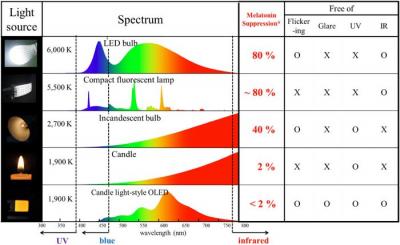A senior VP at LGD recently declared in the IMID Display Business Forum in Korea that according to measurements done by the company, LCD screens emit 3.1 times more blue light than OLED screens. The measurements were done 120 cm away from TVs, 60 mm from monitors and 30 cm from smartphones (TVs are larger and emit more blue light than other types of screens).

Blue light is high energy visible light, widely acknowledged to bear harmful effects like discomfort to the eye and damage to the retina, as well as serve as a contributing factor to diseases such as cancer, diabetes, heart disease, obesity and insomnia. Children seem to have delicate retinas that are highly susceptible to the dangers of blue light.
In addition to all this, blue-light LEDs, which are a staple of LCDs, have been found to have a tendency to attract flying insects. A lot of them.
Comments
Dear Mr. oled,
I hope you're joking because the writing about the diseases is utter bullshit.
Yours truly,
James
My eyes burn every day looking at my LED backlit monitors. PLEASE PLEASE PLEASE somebody develop AMOLED monitors.
My Galaxy tab s is so much easier on my eyes...
James - maybe you think this is a joke, but the world's top doctors think otherwise.
Agreed. I've been longing for the day that I can have a 23-27 inch 1080p OLED monitor. I'm hoping LG does this soon!
at least the chart up there, comparing a 6000k LED bulb to a 1900 K OLED is misleading (James would say "utter bullshit");
potentially by purpose, as somebody wanted to make a point. You can also make LED light sources with similar emission profile, if you want; so far nobody has done it, similar to the 1900K OLED (never seen one in the market);
What is also misleading, is the statement, that blue light would cause all these diseases;
Blue light is an essential component of the natural light spectrum; the question is, when to get blue light exposure;
for office-workers, a high-blue light content could be beneficial; If you would install 1900 K light sources in offices, people would get sick the same way.
The circadian rhythm would get into disorder, as your melatonin production would not be suppressed and people would feel tired all day; this can end up in sleep disorder patterns, unhealthy eating habbits (use sugar to stay productive) and so on;
So I feel it is very misleading to condem blue light as harmful. It is essential, but during the right times.
Seriously I gotta agree with James: This bit of "news" is not worthy of OLED-info
Yes, blue light CAN seriously damage your retina and cause other health issues. However this is a very complex topic and a general statement saying that OLEDs emit less blue light and are thereful less harmful than LCDs ranks somewhere between stupidity and ignorance.
And as for that picture...good luck trying to use this sort of OLED for displays...
Guys, if you look at the emission spectrum of an LED-monitor and that of an OLED-smartphone both the amount of blue light as well as the wavelength of the light are actually extremely similar.
The reason a smartphone screen might be "easier" on the eyes is because your it is by definition mobile so you always adjust it to have a good viewing angle and such. With a desktop monitor you rarely do this and at best adjust your seating position consequently your eyes have to adapt much more leading to less comfort.
bullshit, it's all about wavelenghts of blue light. indigo have better color rendering(and violet have even better), but sky blue as primary have poor color rendering. Also 1900K is not white, i am even cant call it yellow.
that's why so much words and speculations, dumbass "blue filter" software released, but why no one hadn't just replaced 450 nm blue led by 480nm blue led as primary blue color???
You can turn on the blue light filter on your phones and your PCs. Windows supports a blue light filter in their Display Settings section. I leave it turned it on all the time. (I have three LCD monitors, and I use an OLED Samsung Note phone).


right, LCD have a tendency to atrract a lot of insects. Flying insects! Now that is a problem.